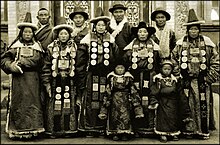


A Yugur family in Lanzhou, Gansu, 1944
| |
| Total population | |
|---|---|
| 18,000 (est.) | |
| Regions with significant populations | |
| Sunan Yugur Autonomous County, Gansu, China | |
| Languages | |
| Western Yugur, Eastern Yugur | |
| Religion | |
|
| |
| Related ethnic groups | |
|
The Yugurs, Yughurs, Yugu (Chinese: 裕固族; pinyin: Yùgùzú; Western Yugur: Sarïg Yogïr; Eastern Yugur: Šera Yogor), traditionally known as Yellow Uyghurs,[1] are a Turkic-Mongolic ethnic group and one of China's 56 officially recognized ethnic groups, consisting of 16,719 persons, according to the 2000 census.[2] The Yugur live primarily in Sunan Yugur Autonomous CountyinGansu. They are mostly Tibetan Buddhists.[3][4] The majority of Yugurs speak a Turkic language, while Mongolic and Chinese are also used in eastern provinces.
The Turkic-speaking Yugurs are considered to be the descendants of a group of Old Uyghurs who fled from Mongolia southwards to Gansu after the collapse of the Uyghur Khaganate in 840, where they established the prosperous Ganzhou Uyghur Kingdom (870-1036) with capital near present Zhangye at the base of the Qilian Mountains in the valley of the Ruo Shui.[5]
In 1037, the Yugur came under Tangut domination.[6] As a result of Khizr Khoja’s invasion of Qumul, many residents who rejected conversion escaped to nearby Dunhuang and Hunan in China proper. These became the ancestors of the modern Yellow Uyghurs, who have remained Buddhists to the present day.[7]
In 1893, Russian explorer Grigory Potanin, the first Western scientist to study the Yugur, published a small glossary of Yugur words, along with notes on their administration and geographical situation.[8]
About 4,600 Yugurs speak Western Yugur (a Turkic language) and about 2,800 Eastern Yugur (a Mongolic language). Western Yugur has preserved many archaisms of Old Uyghur.[9][10]
Both Yugur languages are now unwritten, although the Old Uyghur alphabet was in use in some Yugur communities until end of 19th century.[11]
|
| |||||||||||
|---|---|---|---|---|---|---|---|---|---|---|---|
Underlined: the 56 recognized ethnic groups | |||||||||||
| Sino-Tibetan |
| ||||||||||
| Austroasiatic |
| ||||||||||
| Austronesian |
| ||||||||||
| Hmong-Mien |
| ||||||||||
| Mongolic |
| ||||||||||
| Kra–Dai |
| ||||||||||
| Tungusic |
| ||||||||||
| Turkic |
| ||||||||||
| Indo-European |
| ||||||||||
| Others |
| ||||||||||
| Related |
| ||||||||||
| |||||||||||
|
| |||||||||||
|---|---|---|---|---|---|---|---|---|---|---|---|
| History |
| ||||||||||
| Proto-Mongols |
| ||||||||||
| Medieval tribes |
| ||||||||||
| Ethnic groups |
| ||||||||||
See also: Donghu and Xianbei · Turco-Mongol | |||||||||||
| Authority control databases: National |
|
|---|